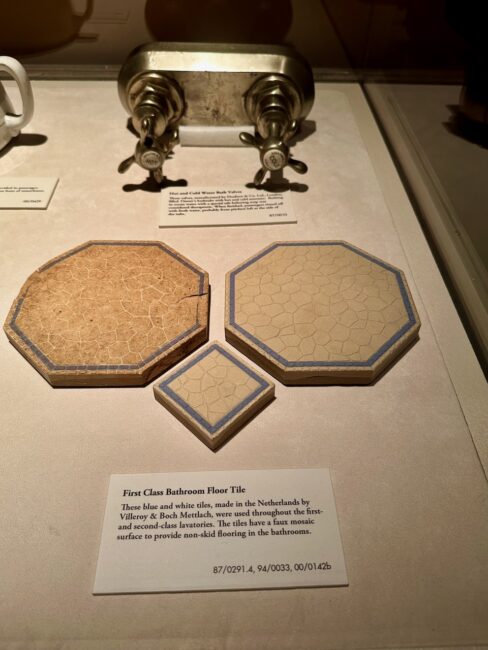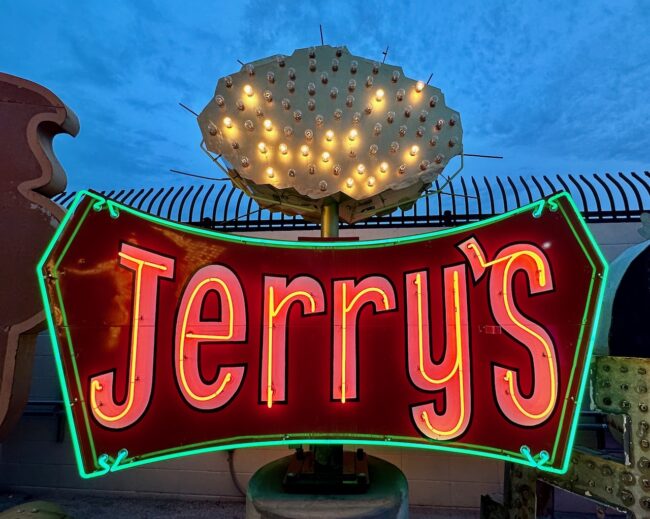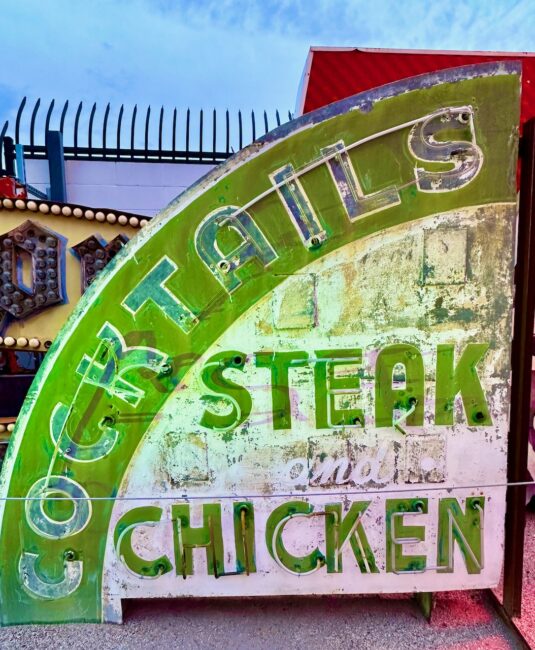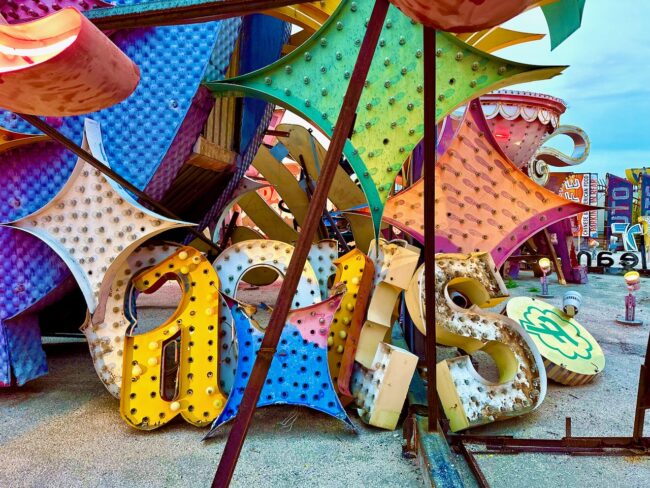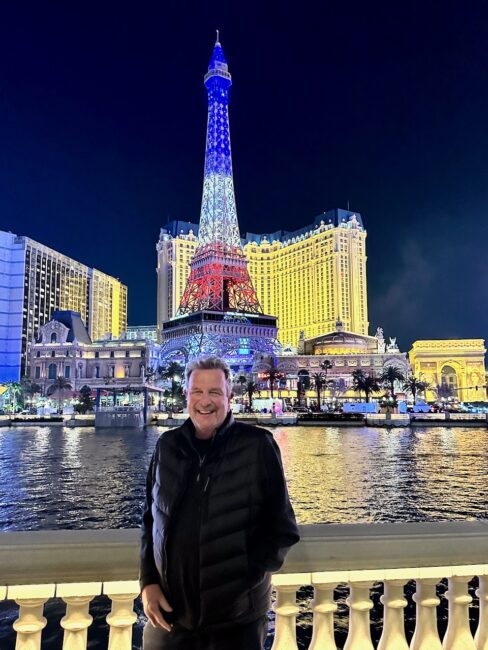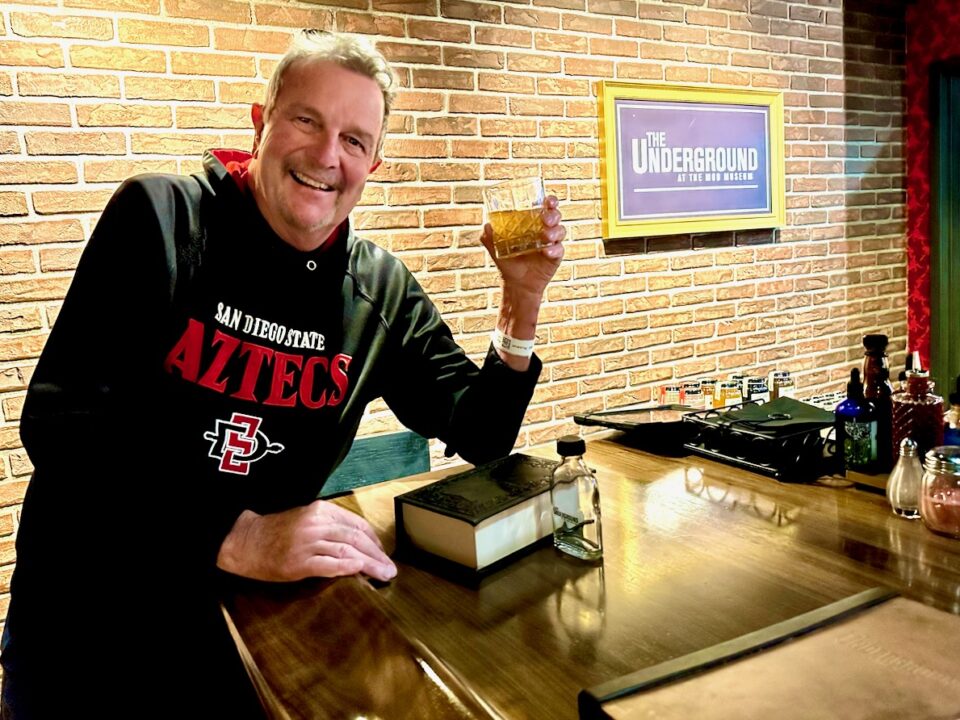
Chapter Two: Don’t You Step On My Blue Suede Shoes
March 6, 2024All Bets Are Off: Mai Tai Tom’s 66 Hours In Las Vegas
Chapter Three: Sunken Treasures To Neon Pleasures
Day Three: We’re Off The Hook, On A Roll, Somber Reminders, The Unsinkable Molly Brown, Don’t Lick The Iceberg, A Hull Of An Artifact, Where’s Bugsy?, Sign Sign Everywhere A Sign, Stardust Memories, Between A Hard Rock & A Fun Place, Tres Merveilleux, No Rollercoasters & No Gambling
I went down early to the desk to see how much money we had “spent” on the infamous snack mini bar, and I guess we had put down the items before the meter started running, so thankfully we were off the hook. We had one more full day left in Vegas, and we decided to make the most of it. After meeting Kevin for breakfast at the Paris Las Vegas Mon Ami Gabi restaurant, where I devoured a cinnamon roll waffle that would have served the entire wedding party, Tracy and I sailed out to see a shipwreck.
Not just any shipwreck, however. The Luxor Hotel & Casino offers Titanic: The Artifact Exhibition, and we had purchased timed tickets ($34) online to take the self-guided tour. The 25,000 square-foot exhibition displays an array of items (more than 350) that have been collected from the ship that lies 2 1/2 miles below the North Atlantic. I said hello to Anubis, one of the most familiar gods of ancient Egypt, outside the hotel.
Before entering the exhibit we were each given a boarding pass with the name of one of the actual passengers aboard the Titanic that fateful night. At the end of the tour, we were to learn if we survived. I didn’t have high hopes for me.
I was 47-year old Samuel Goldberg traveling with my wife Nella. Our cabin was in first class and we were well known dog lovers and breeders. Tracy was Hilda Mary Slayter (30), who was on her way to get married.
Both Tracy and I were impressed by the entire experience, which was also very moving at times.
At the entrance is a miniature model of a Nautile submersible that three crew members would take down to Titanic’s ruins to retrieve artifacts. Being a tad claustrophobic, I could not imagine taking that tiny sub 2 1/2 feet down, much less 2 1/2 miles.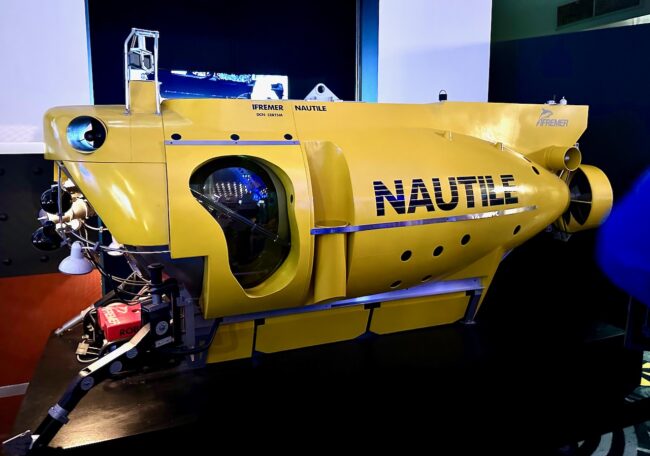
The first stop was a recreation of the ship’s mail room. How big was this ship? Besides the 2,240 passengers and crew, the ship carried 3,364 mailbags.
As we walked along there were placards on the wall telling stories about some of the passengers and crew. They were fascinating and many of them incredibly poignant. Rev. Thomas Byles was headed to the U.S. to officiate in his brother’s wedding and switched to the Titanic from another vessel. He refused on two occasions to get in a lifeboat in order to continue assisting many third class passengers up to the deck with lifeboats.
These stories were displayed throughout the experience, and it just seemed fate destined some of the people to be on this ship. (click on the photos and they enlarge to where you can read the stories)
Yep, this is “The Unsinkable Molly Brown.”
The richest person on the Titanic, John Jacob Astor, was worth about $87 million. In Walter Lord’s book, A Night to Remember, Lord wrote, “After [the Titanic] sank, the New York American broke the news on April 16 with a lead devoted almost entirely to John Jacob Astor; at the end it mentioned that 1,800 others were also lost.”
We then visited a replica of a third-class passenger room, which cost about $40. By comparison, Astor’s first-class room cost $4,500 (more than $100,000 in today’s dollars).
Second class was a tad cheaper than Astor’s room, but still pretty steep … $1,776 (almost $11,000 today).
It’s remarkable to think that these fragile items survived the sinking and nearly 100 years …
… at the bottom of the ocean.
Deck signs, bathroom items along with even beer and wine bottles are displayed.
First-class passengers could enjoy the Promenade Deck which extended 500 feet on both sides of the ship. On this replica you can stroll and see what passengers looked out at on that dark, cold North Atlantic night. We learned that most of the passengers didn’t drown, but died of hypothermia from the 28-degree water.
The most lavish part of the Titanic was its magnificent Grand Staircase. This is also recreated in the exhibit (no photos). However, there is a photographer who will take a few pictures of you that you can purchase at the end of the tour. Being good consumers, we did purchase a couple. I really should have dressed better for the cruise. I hope we’re found.
If we’re not, at least I was romantic until the end.
Next we entered a room with a gigantic iceberg … and a number of noisy school children. They were enthralled with the iceberg, feeling it, with many of them licking the ice (I guess they’ve never seen A Christmas Story). One of them left this handprint.
I, of course, did the same thing until Tracy sighed, “Do you really want to put your hand where those kids just stuck their tongues? Tom, you idiot!” At least I didn’t yell, “I’m the King of the World!”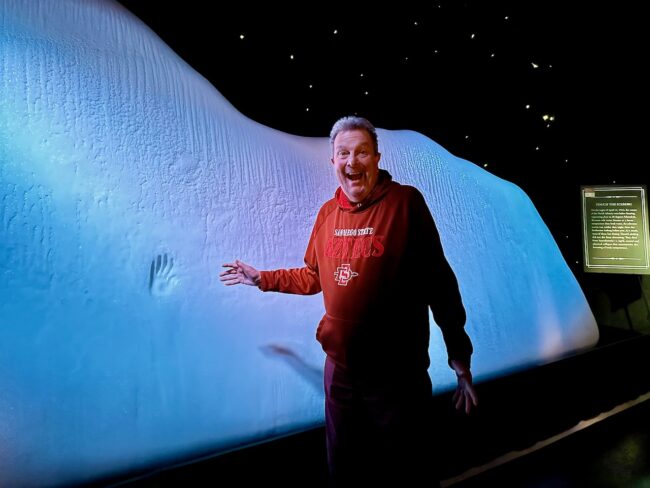
There was no moonlight on that fateful night so lookout Frederick Fleet had a rough time seeing if any icebergs were on the horizon. He could have used these binoculars that belonged to a passenger.
A docent told us how these dishes were meticulously collected from the ship.
These items remind us the voyage was no cup of tea.
Also in this room was a deck light and a Telemotor Wheel Hub, which Quartermaster Hichens tried to turn in a valiant attempt to avoid the iceberg. It was too late. Traveling at 22 knots, by the time the iceberg was spotted, he had no chance of changing the course of Titanic in time.
One of the binnacles for the navigational compass was also found.
There was a replica of the ship resting on the ocean floor.
This is all that remains of a deck bench.
These dress boots serve as a reminder of the many people who perished. More than 1,500 of the estimated 2,240 people on board were killed.
Finally, we came upon “The Big Piece,” so named because this actual giant section from the Titanic’s starboard hull weighs in the vicinity of 15 tons.
It is the largest piece of the Titanic ever raised from the ocean floor. Using lift bags, an expedition team was able to recover the 15-ton piece in 1998. According to what I read, “Nautile would secure the hull-piece with cables that would later be attached to floatation bags, and upon release, the flotation bags would lift the piece to the surface.” Pretty amazing to see.
At the end of the tour, we wanted to spend time looking up what happened to the people on our boarding passes. Unfortunately the 20+ students were there ahead of us, so it would have been a long wait. Luckily the internet provided the information as to our fate. According to Encyclopedia Titanica, Hilda, who was in 2nd class, “shared a cabin with Florence Kelly. In her trunks were ‘one satin opal and pearl wedding dress with silver opal and mesh scarf, satin slippers, silk stockings and a hair bandeau,’ worth $4,000. There was also a ‘blue satin silver net dress, silver and blue scarf, silver tissue and osprey and Italian embroidered lace hand made blouses’ worth another $3,000. She survived and lived until 1965.
As for Mr. Goldenberg … From Encyclopedia Titanica, “Mr. and Mrs. Goldenberg were rescued in lifeboat 5. Dressed only in his pyjamas and dressing gown, with a raincoat and heavier coat over the top and with only slippers on, he brought two rugs from the stateroom, one for he and his wife, and a large canvas bag containing luggage. Mrs. Goldenberg later recalled (New York Herald, 21 April 1912): Mrs. Goldenberg ran out on deck. Mrs. Goldenberg, who had not waited to dress, but had only pulled a skirt over her night dress, was helped into one of the first boats by Mr. Goldenberg, Mr. Ismay and one of the Titanic’s officers. She begged her husband to follow her, but he refused. The boat was unfilled when the crew started to lower it, according to Mrs. Goldenberg, and she urged her husband to take a place, as other men had done. “When I saw that he was not coming,” said Mrs. Goldenberg, “I called, ‘For God’s sake say goodby to me then,’ and suddenly Mr. Ismay and one of the crew seized Mr. Goldenberg and threw him over the side. He managed to catch the boat ropes and I and others pulled him in.” Both died in the mid 1930s. They had divorced by then.
The Titanic exhibition is dedicated to the ship’s last living survivor.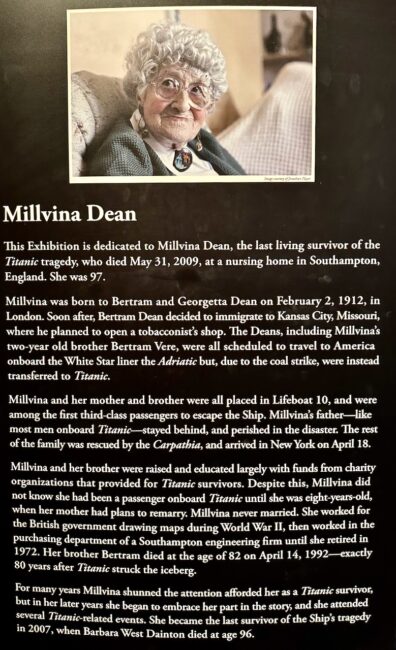
We met back up with Kevin at Paris Las Vegas, and the three of us took last night’s short-cut over to the Flamingo. Since I had read all about mobster Bugsy Siegel at the Mob Museum a couple of days before, I wanted to stop by his monument at the hotel he founded. Interestingly, when we asked the hotel desk personnel where it was located, they didn’t have a clue. One person didn’t even know there was such a thing. If Bugsy had been alive, that guy probably would have been whacked. Finally, we learned the monument was near the wedding chapel in the gardens. We went “in search of” passing by flamingos hiding out in the rain. We at least saw a Flamingo sign.
After a couple of wrong turns, I found the monument, which was nothing special but fulfilled my Bugsy bingo card. Bugsy had a room with bulletproof windows at the Flamingo, but his Beverly Hills girlfriend did not have the same windows at her mansion where Bugsy was gunned down only six months after the Flamingo’s opening.
Back at Paris Las Vegas we grabbed a quick bite at Guy Fieri’s Flavortown, hopped in the car and made our way to The Neon Museum with the clever slogan, “History. Brought To Light.” I had heard great things about this museum and it was tops on my list for our Las Vegas visit (well, except for that whole wedding thing).
We arrived in late afternoon so we could see the signs in daylight, and then light up as night approached. The museum building where you enter was once the lobby of the 1961 La Concha Motel, which was designed by famous African American architect Paul Revere Williams. The lobby was donated in 2005 and had to be cut in eight pieces to be placed here. We’ll see the building lit in different colors later in the post.
We entered what is called The Boneyard, a term used to “refer to a place where signs are retired following their period of use.”
What’s hard to miss as we started our walk through the Boneyard was the museum’s largest restoration piece. You talk about “high strung!” Modeled after a Gibson Les Paul model played by The Who’s Pete Townshend, it stood for 26 years before the hotel closed in 2016. We’d see it at night later.
Famous hotel signs dot the Boneyard landscape.
I believe you needed a reservation to stay here. This is the oldest operational sign in the Neon Boneyard and dates way back to 1940.
My favorite all-time Vegas hotel was the Stardust.
As a teenager, I stayed at the Stardust with my parents on many occasions.
My dad’s company was involved in getting the costumes for the Lido de Paris show at the Stardust through customs, and one of his closest friends designed the sets.
Thanks to those connections I was able to attend these shows as a minor, and for a young boy those scantily clad showgirls were, should I say, memorable. Sadly, the Stardust shut down operation in 2006, but the Lido sign was restored and in a ceremony in February 2023, it was lit up for the first time at the Neon Museum.
Some people say that people who won a lot at Binion’s Horseshoe were ringers. I was not one of them.
Once upon a time the Neon Museum owned two of Treasure Island’s huge skulls, but one of them crumbled due to the Vegas heat. Aye am sure that was an arrghful sight to witness.
We took the cue to see this 1983 pool player sculpture that was located atop Doc ’n Eddys Pool Hall. I believeI heard him say, “Give me a break.”
Betty Willis, the woman who designed the famous “Welcome to Fabulous Las Vegas” sign …
… also designed the famed Moulin Rouge sign. The Moulin Rouge was the first major casino in Vegas to be integrated. Once this sign is renovated and is fully lit, it should be even more fantastic.
Although you can lose your shirt gambling in Vegas, Steiner Cleaners’ “Happy Shirt” showed you can also have them cleaned and pressed here, as well.
I was suddenly hankering for a sizzling steak.
This is part of a large segment from Binion’s Horseshoe on Fremont Street.
As late afternoon turned into evening, the neon shined even brighter …
 … and the Boneyard took on a different look …
… and the Boneyard took on a different look …
… with nuggets (the Golden Nugget, to be exact) like these.
After looking at these three letters, I told Pat Sajak that I needed to buy a vowel.
Then I realized they stood for our new corgi Garbo, our cat Sebastian and our late corgi Remi. No vowels needed.
There were more restaurants.
I felt like singing Ol’Man River at this sign.
… struck a chord in daylight and early evening.
Every turn …
… was a photo op.
The Anderson Dairy sign is from the 1950s. Coincidentally, Tracy mentioned here that I was really milking my jokes by now.
The Sahara and Fitzgerald signs were both given to the museum intact.
I have to ask Kari and Paul if this is where they got information about their ceremony.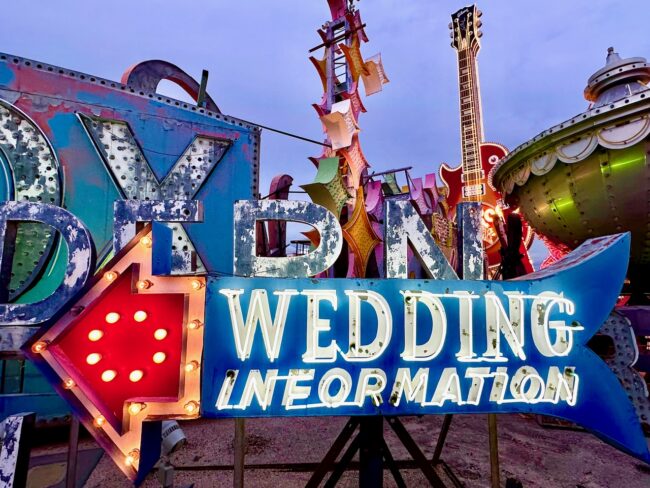
The Palms showed off its colors.
We loved this shot of the Stardust juxtaposed with the Hard Rock. 
The Hard Rock guitar sign was donated and restored by Young Electric Sign Company (YESCO). That company, along with AD-ART and Federal Signs were responsible for a number of signs that dotted the Vegas skyline.
We could tell it was cocktail hour. A Manhattan beckoned at The Red Barn, which was one of the “first openly gay bars in Las Vegas in the 1970s.”
Or perhaps it was time for a margarita in a souvenir yard glass from Margarita Baby Pizza Kitchen, a restaurant that was once down the street from the Wynn.
Walking through the Neon Boneyard made me feel a little Sassy.
We had hit literally hit the Jackpot on this tour.
We wanted to stay longer as the sky turned an even deeper shade of blue …
… but we decided the cold weather was winning on this frigid Vegas evening. One last look at the La Concha sign …
… and a farewell smile from the Ugly Duckling Car Sales, and we were on our way.
In our opinion, this is a must-see place when you come to Vegas especially in the evening after the signs are turned on and the sky deepens to a velvet blue.
It’s truly a one-of-a-kind experience.
Paul Revere Williams was one of the most successful architects of the 20th century, designing more than 3,000 structures, including many buildings in Los Angeles. His story is quite fascinating. Here are a few views of the Neon Museum, which was once the lobby of the historic La Concha Motel.
Although it was not near midnight, but we did see the Silver Slipper on the way out.
Since the highway was jammed due to an accident, we got on our high horse and hightailed back through town …
… catching a few more signs along the way.
Back to Paris we drove.
Our dinner that evening was at the hotel’s French restaurant, Mon Ami Gabi.
The food was terrific, the service impeccable and our long last day in Vegas was complete. Tomorrow we’d drive home with one last sight along the way.
Chapter Four: Leaving Las Vegas
Day Four: You Mean There’s More Than One Magic Mountain? & Let It Snow Let It Snow Let It Snow!
After dropping Kevin off early for his flight to Colorado Springs, Tracy and started the 4-hour+ journey home. ”Let’s stop at Magic Mountains,” she said. “I’m really not in the mood for a roller coaster after three days in Vegas,” I replied.
“Not Magic Mountain, but Seven Magic Mountains,” she said. I’m a bad listener. Less than a half hour west of Las Vegas just off Interstate 15 near Jean Lake stands this public art installation created by Swiss artist Ugo Rondinone that opened in May 2016.
Seven colorful, stacked boulders (hence Seven Magic Mountains) more than 30 feet high can be seen from the highway, although you have to take a nearby exit traveling in either direction to see it up close.
It was originally supposed to be displayed for a couple of years, but by popular demand it remains here still today. Rindinone has an interest in natural phenomena, and this was “inspired by naturally occurring Hoodoos and natural rock formations.” So go do that Hoodoo that you do so well!
Finally, about 20 minutes after passing Baker, California, we ran into a little bit of a snow storm …
… but soon we were back home, culminating our whirlwind trip to Sin City.
Sixty-six hours is our limit for Las Vegas, and we had a blast. From Mobsters …
… to Lunar New Year displays …
… and dazzling displays of Neon …
… it had a little bit of everything, except for one detail. For the first time as an adult I didn’t make one single bet in Las Vegas. You could have put odds on that. Au revoir for now, but always remember (even if you think you’ll be charged $15 for Pringles you didn’t eat) …
Enjoy The Journey!
Attitude Is Everything!













